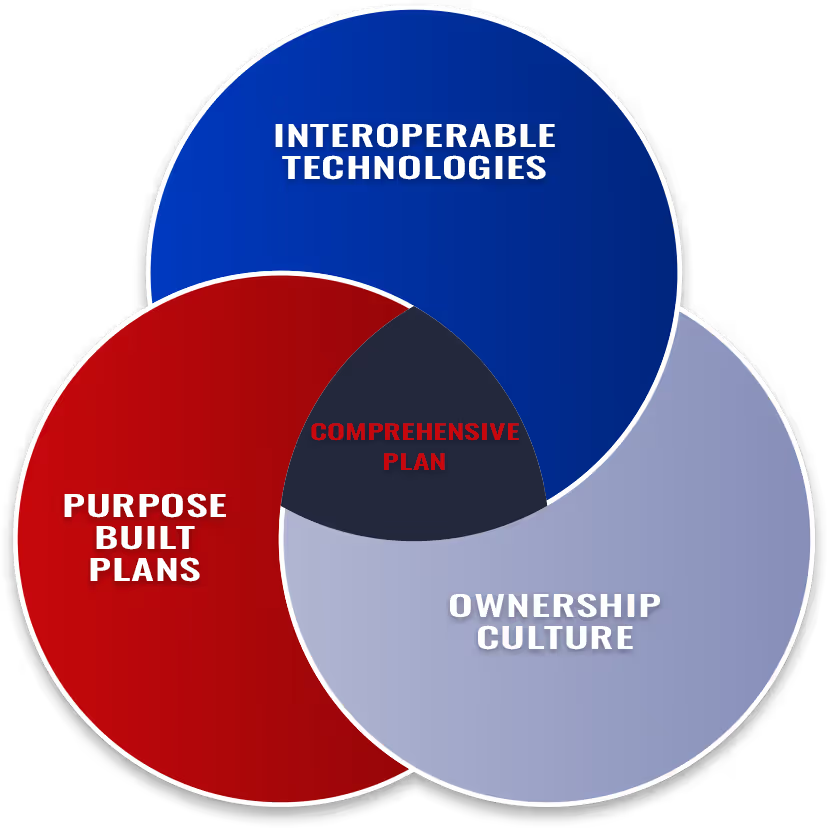
ICU Blog and News
3 Fundamentals of a Comprehensive School Safety Plan

Creating holistic safety and security plans for your school campus can be a daunting task. These “solutions” are often not solutions at all. In fact, most security “solutions” are often not much more than a slew of disparate systems and policies that are neither sustainable nor tempered.
It’s Been Right in Front of us the Whole Time.
After diving into the details of many of our nation’s infamous school tragedies over the past three decades, it has become clear there are essential takeaways that we must all feel obligated to ensure are in our own safety plans.
There are three fundamental elements that must be represented in our safety and security plans, and it’s been right in front of us the whole time. In nearly every tragedy within our schools over the past 30 years, there was a failure in one, two, or all three of these fundamental elements.

Let’s Dive into the Elements.

The first element is Interoperable Technologies. Too often the security technologies installed in schools only serve one function. Rarely have security technologies been selected with interoperability in mind. Take, for instance, cameras. The sobering fact is 100 percent of school shootings in the last three decades have all had cameras. Cameras don’t prevent bad things from happening. The bottom line is that the cameras served only to memorialize these traumatic disasters and were more useful to the forensic team than they were to the K-12 students and staff ahead of time as a preventative tool and protecting them in the moment.
Systems that are Purchased with the Intent to Contribute to Safety and Security must all be Interoperable.
- The camera system should be tied into the access control.
- The vaping sensors should be tied to the cameras and to the access control.
- The paging/intercom system should be tied to cameras, access control, and the sensors.
This isn’t science fiction anymore. All of these systems are IP-based and on the network. The entire point of putting them on the network is to make them easier to access and for their interoperability. Yet, most districts have nothing more than disparate products working independently and unable to meaningfully participate in a holistic plan – especially a plan that “holds up” when a tragedy is occurring.

It’s not enough to only focus on installing interoperable technologies. The second fundamental element, Purpose Built Plans, must be defined and implemented. For example, we can empower campuses with the knowledge to react effectively in a crisis with constructive purpose-built policies and procedures in place.
Purpose Built Plans are comprehensive and should consider the plans for all staff, anyone on campus, first responders, and parents. They should maintain integrity regardless of time of day or year. They should also pragmatically handle policy conflicts by clearly defining priorities and which actions take precedence. For example, defining what students do when a fire alarm goes off during an active shooter scenario is paramount. The United States has had two incidents in recent history where the fire alarms were used by an assailant to lure victim into the open. We’ve lost too many lives to the absence of comprehensive and purpose-built plans.
Comprehensive Doesn’t Mean Complex.
Simple concepts such as training staff and students to cover the windows and hide in “hard corners,” is essential to a good safety plan. An entire floor of students in the Parkland shooting were unharmed because simple protocols were followed. Meanwhile, many of the first-floor victims were due to the absence of these simple tactics. This demonstrates that Purpose Built Plans can keep students and teachers safe longer, buying them valuable time until law enforcement arrives.

We like to use an airport analogy when describing the third element. When we ask people, “Who owns security in an airport?” the answer almost always comes back, “TSA!” But, TSA only owns security at the check points. Typically, airports have a dedicated security team for all other areas of the airport. Additionally, each of us own security when the announcements continuously remind us to call security when we see anything suspicious such as a bag left behind. The fact is, many different people and agencies own security at an airport – and we’ve all accepted this. That is ownership culture.
Why Should We have a Stronger Ownership Culture at the Airport than at a School?
Teachers need to be encouraged to own the security of their classroom, and students need to know their roles wherever they are on campus. Countless students remained safe in the Oxford school shooting incident because students and teachers executed the plan and demonstrated ownership through diligence and perseverance.
Staff need to be empowered and feel confident in owning campus safety. In Parkland, the absence of ownership led to an intruder seen beforehand by multiple staff go unchecked leading to the unnecessary death of many innocent victims. It seems easy for us now to ask why they didn’t call a code red when so many staff saw the intruder, but this problem is rooted in the absence of an ownership culture.
How Can We Help?
Developing a comprehensive security and safety plan is daunting, but it’s not impossible. We all owe it to the countless number of victims to be better – to demand more of ourselves. The three fundamental elements can be an excellent guide when designing and deciding on the safety plan, and good vendor partners are an essential piece of the puzzle.
The right partner should have expertise in campus environments and have valuable contributions to all three of the fundamental elements. It’s time to stop buying security products through poorly written RFPs, running menial drills that aren’t aligned with today’s realities, and reusing old policies copied from other districts. It’s time to Demand More.
